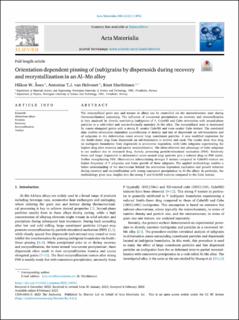| dc.contributor.author | Ånes, Håkon Wiik | |
| dc.contributor.author | Van Helvoort, Antonius | |
| dc.contributor.author | Marthinsen, Knut | |
| dc.date.accessioned | 2024-01-04T07:33:30Z | |
| dc.date.available | 2024-01-04T07:33:30Z | |
| dc.date.created | 2023-02-16T09:55:48Z | |
| dc.date.issued | 2023 | |
| dc.identifier.citation | Acta Materialia. 2023, 248 . | en_US |
| dc.identifier.issn | 1359-6454 | |
| dc.identifier.uri | https://hdl.handle.net/11250/3109676 | |
| dc.description.abstract | The recrystallized grain size and texture in alloys can be controlled via the microchemistry state during thermomechanical processing. The influence of concurrent precipitation on recovery and recrystallization is here analyzed by directly correlating (sub)grains of P, CubeND and Cube orientation with second-phase particles in a cold-rolled and non-isothermally annealed Al–Mn alloy. The recrystallized state is dominated by coarse elongated grains with a strong P, weaker CubeND and even weaker Cube texture. The correlated data enables orientation dependent quantification of density and size of dispersoids on sub-boundaries and of subgrains in the deformation zones around large constituent particles. A new modified expression for the Smith–Zener drag from dispersoids on sub-boundaries is derived and used. The results show that drag on (sub)grain boundaries from dispersoids is orientation dependent, with Cube subgrains experiencing the highest drag after recovery and partial recrystallization. The often-observed size advantage of Cube subgrains is not realized due to increased drag, thereby promoting particle-stimulated nucleation (PSN). Relatively fewer and larger dispersoids in deformation zones around large particles give a reduced drag on PSN nuclei, further strengthening PSN. Observations substantiating stronger P texture compared to CubeND texture are higher frequency of P subgrains and faster growth of these subgrains. The applied methodology enables a better understanding of the mechanisms behind the orientation dependent nucleation and growth behavior during recovery and recrystallization with strong concurrent precipitation in Al–Mn alloys. In particular, the methodology gives new insights into the strong P and CubeND textures compared to the Cube texture. | en_US |
| dc.description.abstract | Orientation dependent pinning of (sub)grains by dispersoids during recovery and recrystallization in an Al–Mn alloy | en_US |
| dc.language.iso | eng | en_US |
| dc.publisher | Elsevier B. V. | en_US |
| dc.relation.uri | https://doi.org/10.5281/zenodo.7383087 | |
| dc.rights | Navngivelse 4.0 Internasjonal | * |
| dc.rights.uri | http://creativecommons.org/licenses/by/4.0/deed.no | * |
| dc.subject | Aluminium | en_US |
| dc.subject | Aluminium | en_US |
| dc.subject | Rekrystallisasjon | en_US |
| dc.subject | Recrystallization | en_US |
| dc.title | Orientation dependent pinning of (sub)grains by dispersoids during recovery and recrystallization in an Al–Mn alloy | en_US |
| dc.title.alternative | Orientation dependent pinning of (sub)grains by dispersoids during recovery and recrystallization in an Al–Mn alloy | en_US |
| dc.type | Peer reviewed | en_US |
| dc.type | Journal article | en_US |
| dc.description.version | publishedVersion | en_US |
| dc.subject.nsi | VDP::Kondenserte fasers fysikk: 436 | en_US |
| dc.subject.nsi | VDP::Condensed matter physics: 436 | en_US |
| dc.source.volume | 248 | en_US |
| dc.source.journal | Acta Materialia | en_US |
| dc.identifier.doi | 10.1016/j.actamat.2023.118761 | |
| dc.identifier.cristin | 2126536 | |
| dc.relation.project | Norges forskningsråd: 309584 | en_US |
| dc.source.articlenumber | 118761 | en_US |
| cristin.ispublished | true | |
| cristin.fulltext | original | |
| cristin.qualitycode | 2 | |

